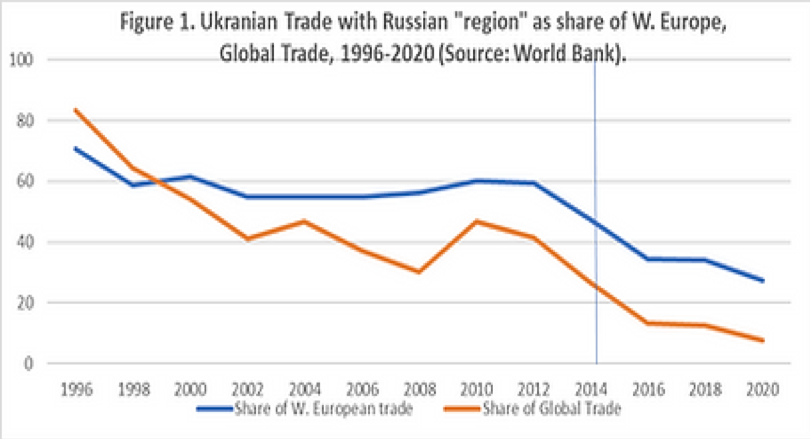By Dr. Thomas Volgy
As of this writing the most significant hostilities in Europe since World War II continue unabated between Ukraine and the Russian Federation. While there have been numerous reasons articulated for the start of the conflict, one underlying contributor may have been the major changes in economic and trade relations between the two states, reflecting Ukraine’s movement away from the Russian Federation and its post-Soviet space.
This suggestion should not be surprising. The earlier Maidan uprising of 2013-2014 had been triggered by then President Victor Yanukovych’s refusal to create closer economic relationships with the European Union. That decision resulted in major street demonstrations to which the Ukrainian government responded with a range of repressive measures leading to numerous civilian deaths, Yanukovych fleeing Ukraine, the Ukrainian parliament holding new elections, newly elected President Petro Poroshenko delivering a reformist coalition government, and Russia fomenting a separatist rebellion in eastern Ukraine and annexing the Crimea.
Deteriorating economic relations between Ukraine and the Soviet space from which it secured its independence is consistent with the argument in the trade-conflict literature about opportunity costs involving trade relationships. The greater the trade interdependence between two states, the greater the cost of increased conflict between them; conversely, the reduction of such trade interdependencies decreases opportunity costs for increased conflict. Just as salient, decreasing trade relations can raise large questions in the minds of decision makers (especially in the Kremlin) about the possibility of major foreign policy changes being pursued by adjacent states (Ukraine).
Is there any evidence for the presence of deteriorating economic and trade relationships between the two sides preceding the conflicts between Ukraine and the Russian Federation? Figure 1 illustrates estimates of Ukrainian trade[1] with the Russian Federation and its allies in post-Soviet space[2] as a share of all trade between that grouping and Western Europe, and as well globally. Between 1999 and 2012, Russia and its allies’ share of Ukrainian trade, compared to Western Europe, hovered around 60 percent; by 2014 that share flipped to most of Ukrainian trade being conducted with Western Europe, and by 2020 (the last year for which we have observations) it had declined to less than 30 percent with Russia and its allies. Trade with the Russian bloc as a share of global Ukrainian trade was even more dramatic, decreasing from 64 percent in 1998 to about 7 percent in 2020. Regardless of the measure being used, Ukraine was moving dramatically out of the Russian economic orbit, prior to the annexation of Crimea, and even more so prior to the 2022 invasion of Ukraine.[3]
Trade has both material and symbolic value for the countries involved. In the case of Ukrainian-Russian trade relationship, the dramatic turnaround in Ukrainian trade with the Russian Federation, starting before the annexation of Crimea, but accelerating substantially prior to the 2022 Russian invasion, represents at a minimum for Russia a loss of substantial leverage over the Ukrainian economy and the direction of its foreign affairs. Perhaps just as important for policy makers in the Kremlin, Ukraine’s changing trade patterns represented as well Kyiv’s determination to remove itself from Russia’s sphere of influence and towards a more permanent relationship with both the EU and the larger global community. For those in the Kremlin, the seriousness of Ukraine’s interest in joining NATO (and perhaps the EU) may well have been underscored by Ukraine’s changing trade relations.
[1] Trade is measured as (exports + imports)/2.
[2] Including Belarus, Moldova, Serbia, Russian Federation, Georgia, Azerbaijan, Armenia, Kazakhstan, Kyrgyzstan, Uzbekistan, and Turkmenistan. We exclude those states that are members of the EU or if they had established a path to EU membership prior to 2020.
[3] As another point of comparison, Hungary’s exports, an EU member but with friendly relations with the Kremlin, had, by 2018, exceeded Ukrainian exports to Russia.
